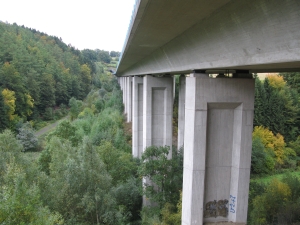The new ResoBridge method has been developed to check bridges during running traffic within one day. It measures the vibrations of the tensioning ropes of externally prestressed concrete bridges. The test method developed by Karlsruhe Institute of Technology helps control the state of infrastructure facilities and optimizes early planning of necessary repairs. In the future, it may also be used to check cable-stayed bridges and constructions as well as hybrid towers of wind power plants.
Nearly 40,000 bridges exist in Germany. They have to withstand enormous loads. In particular, they have to cope with the growing heavy goods vehicle traffic. To guarantee safety of bridges, regular inspections are required. However, visual methods allow the damage to be detected in a rather advanced state only. Other methods, such as ultrasound, radiography or magnet-inductive testing, are time-consuming and expensive. Moreover, the bridges partly have to be closed for the traffic.
The ResoBridge method developed by Lothar Stempniewski and Steffen Siegel of the KIT Institute of Concrete Structures and Building Materials (IMB) represents an inexpensive and reliable alternative. The patented method is suited for concrete bridges with external tendons that are not cast into the concrete. These bridges are equipped with a hollow concrete box underneath the road. Six steel ropes inside the box ensure stability. Such externally prestressed concrete bridges can be found all over Germany.
.jpg)
The tensioning ropes to be checked are located in the hollow concrete box of the bridge. (Photo: S. Siegel/KIT)
The ResoBridge method is based on an acceleration sensor measuring natural vibrations of the tensioning ropes. The values measured are compared to results of earlier measurements. “A decreasing frequency indicates decreasing tension of the rope. Significant changes of the values suggest damage of the wires or braids,” explains Steffen Siegel, IMB. The method measures the frequency spectra with an accuracy of up to 0.01 Hertz. To detect changes, an initial value has to be determined as a reference. The KIT researchers were involved in the development of an instrument that stores all values measured and indicates frequency changes.
The instrument is easy to operate. Measurement of the values, inclusive of the assembly and disassembly of the sensor at the measurement point, takes a few minutes only. The check of a bridge will take one day without the bridge having to be closed for the traffic. Hence, ResoBridge saves time and costs. All bridge data are recorded centrally. The method can also be used to compare various tensioning units and bridges. Presently, the method is being further developed for use on other constructions. Future application to cable-stayed bridges and constructions as well as to hybrid towers of wind power plants is envisaged.
Being “The Research University in the Helmholtz Association”, KIT creates and imparts knowledge for the society and the environment. It is the objective to make significant contributions to the global challenges in the fields of energy, mobility, and information. For this, about 10,000 employees cooperate in a broad range of disciplines in natural sciences, engineering sciences, economics, and the humanities and social sciences. KIT prepares its 22,800 students for responsible tasks in society, industry, and science by offering research-based study programs. Innovation efforts at KIT build a bridge between important scientific findings and their application for the benefit of society, economic prosperity, and the preservation of our natural basis of life. KIT is one of the German universities of excellence.

